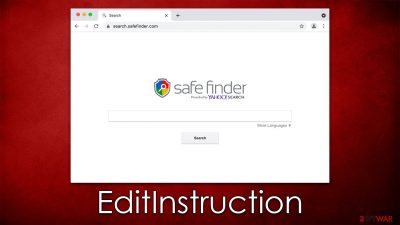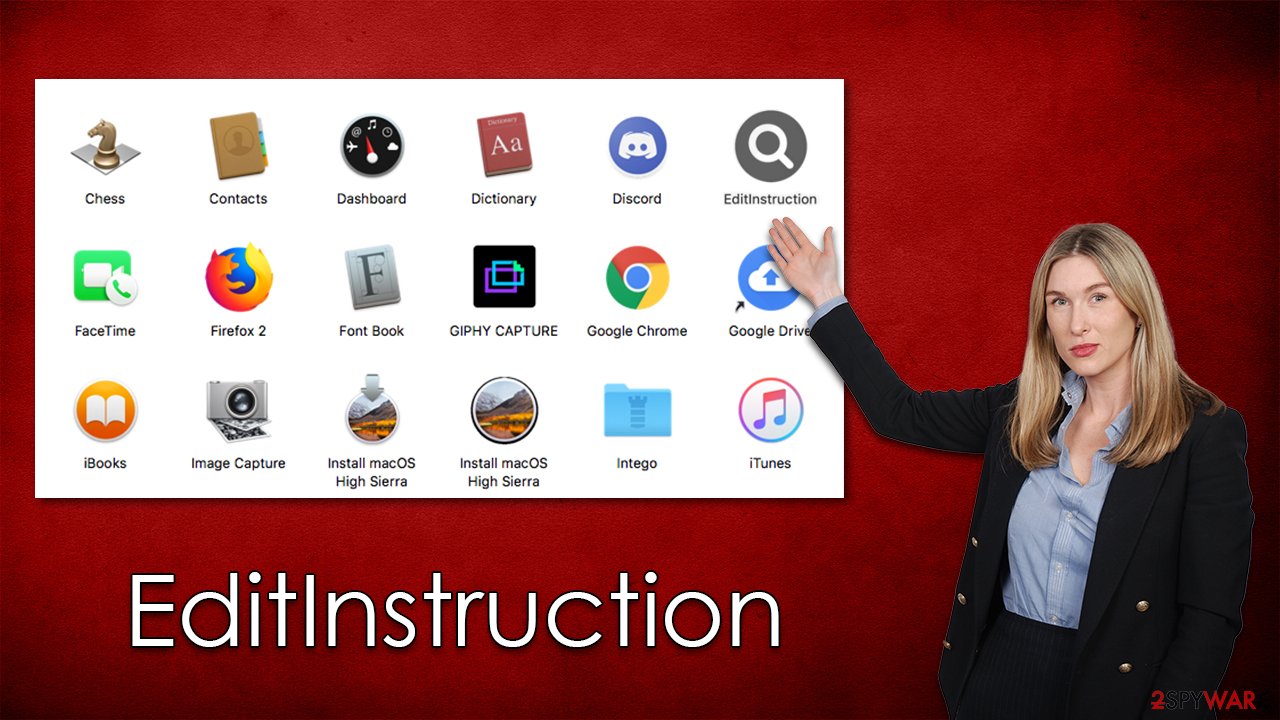EditInstruction Mac virus (Free Guide)
EditInstruction Mac virus Removal Guide
What is EditInstruction Mac virus?
EditInstruction feeds your browsers with ads and steals your personal information

A malicious Mac application EditInstruction is made to hijack web browsers, distribute intrusive advertising, and evade removal by using strong persistence techniques. The virus is a member of the large family of Adload malware, and hackers who created it have already distributed hundreds of variants, each of which possesses harmful characteristics.
Pirated software installers and bogus Flash Player upgrades are two deceptive tactics used to spread malware. Although these techniques are by no means advanced, they are incredibly successful since EditInstruction adware and other versions infect hundreds of people every single day.
Once activated, the virus would often alter browser settings (such as changing the homepage and default search engine to Safe Finder or another provider) and expose users to a variety of sponsored links and annoying ads. These actions may sometimes result in users being shown phishing content, including get-rich-quick[1] scams or fake virus infection alerts.
The browser extension is designed to acquire different personal information, including login passwords or credit card information, creating serious privacy and security threats. Below we explain how to remove the infection and prevent its recurrence effectively.
| Name | EditInstruction |
| Type | Mac virus, adware, browser hijacker |
| Malware family | Adload |
| Distribution | The most common distribution is fake Flash Player installers, |
| Symptoms | An extension installed on the browser with elevated permissions, along with an application of the same name; new profiles and login items set up on the account; malicious ads shown during web browsing activities; search and browsing settings altered to Safe Finder or another search provider |
| Risks | Personal data disclosure to cybercriminals, system compromise, installation of other malware, financial losses |
| Removal | The fastest way to remove Mac malware is to perform a full system scan with SpyHunter 5Combo Cleaner security software. We also provide a manual guide below |
| System optimization | After you terminate the infection with all its associated components, we recommend you also scan your device with FortectIntego to clean your browsers and other leftover files from the virus |
Adload malware explained
Malware on Mac computers is no longer a myth, despite the initial belief of many Mac users. [2] Due to this operating system's rising popularity, hackers began to attack it more frequently over time. Even if it's true that Macs are less prone to harmful malware (such as rootkits and ransomware), Macs still have a major adware problem, and the adware that targets them is typically far more aggressive than that that targets Windows.
For instance, Adload has been active for more than five years and is just one of numerous aggressive adware strains that constantly infect people. It features a unique magnifying glass icon on a background that is often blue, teal, green, or gray, so if you see an extension or an app using it, you are for sure infected with Adload version, be it EditInstruction, IronBrowse, RealInfo, OperativeIndexer, or another version.
Although the many versions of this virus have little difference in how they function or spread, the criminals who built it are always improving its evasion methods. In fact, once users grant access to the virus, it immediately employs AppleScript to prevent Gatekeeper and XProtect[2] – two built-in Mac security systems – from removing it.
EditInstruction may use this integration to install the extension and other components with elevated privileges on the system, allowing it to grab personal data or even download extra payloads without users being aware of it. That is why it's not unusual for several Adload variants to appear on people's computers at the same time.

EditInstruction removal
EditInstruction removal is a process that requires more than simply dragging the application to the Trash – if you do this, reinfection is almost guaranteed. Thanks to its ability to run with administrator privileges, the malware drops several files into key system locations, creates new profiles and login items, etc.
Because of these properties, it's best to forego the manual steps needed for removal and instead depend on robust security solutions. Two examples are SpyHunter 5Combo Cleaner or Malwarebytes. They're not impacted by the virus as built-in Mac's anti-malware is, so they can successfully find and eliminate all malicious components at one time automatically.
We understand that some of you may want to proceed with manual steps, so we have provided all the necessary steps below. Just remember that using the manual method does not guarantee success with malware removal; there could also be payloads that emit no symptoms running in the background and performing malicious tasks behind your back.
To start off, background processes initiated by the EditInstruction virus may hinder the elimination process. This is why it is important to make sure that all the related processes are stopped via the Activity Monitor:
- Open Applications folder.
- Select Utilities.
- Double-click Activity Monitor.
- Here, look for suspicious processes and use the Force Quit command to shut them down.
- Go back to the Applications folder.
- Find the malicious entry and place it in Trash.
![Uninstall from Mac 1 Uninstall from Mac 1]()
Your next task is to remove all the virus-related Login items and new Profiles that could be used by it.
- Go to Preferences and pick Accounts
- Click Login items and delete everything suspicious
- Next, pick System Preferences > Users & Groups
- Find Profiles and remove unwanted profiles from the list.
Finally, you should get rid of the leftover files. The PLIST files are small config files, also known as “Properly list.” They hold various user settings and hold information about certain applications. To remove the virus, you have to find the related PLIST files and remove them.
- Select Go > Go to Folder.
- Enter /Library/Application Support and click Go or press Enter.
- In the Application Support folder, look for any dubious entries and then delete them.
- Now enter /Library/LaunchAgents and /Library/LaunchDaemons folders the same way and terminate all the related .plist files.
![Uninstall from Mac 2 Uninstall from Mac 2]()
Cleaning web browsers
EditInstruction needs access to multiple areas of the operating system in order to function, but the browser is by far the most important. This is because ads are delivered primarily through the browser to users.
First, we advise trying to uninstall the primary browser extension using the same procedure as conventional extensions. Various circumstances may or may not cause this step to be effective (the app might simply be grayed out). Then, to make sure the remains are properly removed, we advise deleting web browser cookies,[3] caches, and other site data.
Resetting your browser would remove everything on it if none of the methods worked and you were still stuck with the browser extension. You might even completely reinstall it as a last resort.
Safari
- Click Safari > Preferences…
- In the new window, pick Extensions.
- Select the unwanted extension and select Uninstall.
![Remove extensions from Safari Remove extensions from Safari]()
Google Chrome
- Open Google Chrome, click on the Menu (three vertical dots at the top-right corner) and select More tools > Extensions.
- In the newly opened window, you will see all the installed extensions. Uninstall all the suspicious plugins that might be related to the unwanted program by clicking Remove.
![Remove extensions from Chrome Remove extensions from Chrome]()
If you were unable to uninstall the extension in a regular way, you could reset your browser instead. Use the following:
Safari
- Click Safari > Preferences…
- Go to the Advanced tab.
- Tick the Show Develop menu in the menu bar.
- From the menu bar, click Develop, and then select Empty Caches.
![Reset Safari Reset Safari]()
Google Chrome
- Click on Menu and select Settings.
- In the Settings, scroll down and click Advanced.
- Scroll down and locate Reset and clean up section.
- Now click Restore settings to their original defaults.
- Confirm with Reset settings.
![Reset Chrome 2 Reset Chrome 2]()
Finally, you should clear browser caches by removing cookies[3] and other trackers. Feel free to employ an automatic solution by using FortectIntego maintenance utility, although you can do this manually as well:
Safari
- Click Safari > Clear History…
- From the drop-down menu under Clear, pick all history.
- Confirm with Clear History.
![Clear cookies and website data from Safari Clear cookies and website data from Safari]()
Google Chrome
- Click on Menu and pick Settings.
- Under Privacy and security, select Clear browsing data.
- Select Browsing history, Cookies and other site data, as well as Cached images and files.
- Click Clear data.
![Clear cache and web data from Chrome Clear cache and web data from Chrome]()
How to prevent from getting adware
Do not let government spy on you
The government has many issues in regards to tracking users' data and spying on citizens, so you should take this into consideration and learn more about shady information gathering practices. Avoid any unwanted government tracking or spying by going totally anonymous on the internet.
You can choose a different location when you go online and access any material you want without particular content restrictions. You can easily enjoy internet connection without any risks of being hacked by using Private Internet Access VPN.
Control the information that can be accessed by government any other unwanted party and surf online without being spied on. Even if you are not involved in illegal activities or trust your selection of services, platforms, be suspicious for your own security and take precautionary measures by using the VPN service.
Backup files for the later use, in case of the malware attack
Computer users can suffer from data losses due to cyber infections or their own faulty doings. Ransomware can encrypt and hold files hostage, while unforeseen power cuts might cause a loss of important documents. If you have proper up-to-date backups, you can easily recover after such an incident and get back to work. It is also equally important to update backups on a regular basis so that the newest information remains intact – you can set this process to be performed automatically.
When you have the previous version of every important document or project you can avoid frustration and breakdowns. It comes in handy when malware strikes out of nowhere. Use Data Recovery Pro for the data restoration process.
- ^ Get rich quick scams. SRA. Solicitors Regulation Authority.
- ^ The Death of the Mac Malware Myth. Digital Uppercut. IT Support and Services.
- ^ What are cookies? | Cookies definition. Cloudflare. The Web Performance & Security Company.








